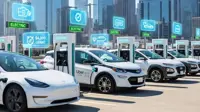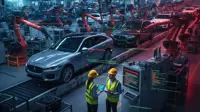New lithium air batteries could be 10x more powerful than current batteries
05 Nov 2015
A new technology could free everything from smartphones to electric cars from the limits placed by flawed lithium ion batteries.
Scientists at the University of Cambridge, have demonstrated how several practical challenges could be addressed before lithium-air batteries emerge as a viable alternative to gasoline.
The researchers developed a lab-based demonstrator of lithium-air battery that has higher capacity, increased energy efficiency and improved stability over previous attempts.
The demonstrator features a highly porous, "fluffy" carbon electrode made from graphene (comprising one-atom-thick sheets of carbon atoms), and additives that alter the chemical reactions at work in the battery, making it more stable and more efficient.
Scientists have known for some time that lithium-air of lithium-oxygen batteries could hold up to 10 times the charge of today's lithium-ion packs. The team at Cambridge University has overcome a number of practical challenges that had earlier prevented lithium-air technology from being a viable option.
"What we've achieved is a significant advance for this technology and suggests whole new areas for research – we haven't solved all the problems inherent to this chemistry, but our results do show routes forward towards a practical device," said Clare Grey, the paper's senior author, in a press statement.
Commentators point out that it was not simply holding more energy, the batteries were also more than 90 per cent efficient and can be recharged over 2,000 times, according to the study. This compares with the efficiency of 80 per cent to 90 per cent of most current lithium ion batteries.
Furthermore, lithium-air batteries could also be five times less costly and five times lighter than today's lithium-ion cells.
If the new batteries were truly 10 times more powerful and five times lighter than batteries currently used in electric cars, the range of electric vechicles could be extended upward of 400 miles per charge - or further than the distance from Los Angeles to San Francisco.
The applications of the technology are not limited to mobility; it could affect mobile devices, too. Smartphone batteries for instance could be 10 times thinner, or 10 times longer-lasting, if it remained the same size.
"What we've achieved is a significant advance for this technology and suggests whole new areas for research - we haven't solved all the problems inherent to this chemistry, but our results do show routes forward towards a practical device," professor Clare Grey of Cambridge's Department of Chemistry, the paper's senior author, wrote (Read more: New design points a path to the 'ultimate' battery).
German mobility technology major Robert Bosch is researching batteries that will make it possible to drive longer distances without recharging, and will also cost less than current batteries. (See: Bosch working on super batteries for electromobility).






.webp)















